Acoplanarity, Aromaticity, Chirality, and Helical Twisting Power of Chlorin e6 13(N)-Methylamide-15,17-dimethyl Ester Complexes: Effect of a Metal
Abstract
1. Introduction
2. Results and Discussion
3. Materials and Methods
3.1. Materials
- Chlorin e6 13-(N)-methylamide-15,17-dimethyl ester (MADMECl)
- Zn-Chlorin e6 13-(N-methylamide)-15,17-dimethyl ester. (Zn-MADMECl)
- Cu-Chlorin e6 13-(N-methylamide)-15,17-dimethyl ester. (Cu-MADMECl)
- Ni-Chlorin e6 13-(N-methylamide)-15,17-dimethyl ester. (Ni-MADMECl)
3.2. Measurement of UV/Vis, CD Spectra
3.3. NMR Measurement
3.4. Quantum chemical Calculations
3.5. Measurement of Phase Transitions Temperatures
3.6. Measurement of Pitch
4. Conclusions
Supplementary Materials
Author Contributions
Funding
Acknowledgments
Conflicts of Interest
References
- Kadish, K.M.; Smith, K.M.; Guilard, R. Handbook of Porphyrin Science with Applications to Chemistry, Physics, Materials Science, Engineering, Biology and Medicine. In Physicochemical Characterization; World Scientific Publishing Co. Pte. Ltd.: Singapore, 2010; Volume 7. [Google Scholar]
- Lucky, S.S.; Soo, K.C.; Zhang, Y. Nanoparticles in Photodynamic Therapy. Chem. Rev. 2015, 115, 1990–2042. [Google Scholar] [CrossRef] [PubMed]
- Le Guern, F.; Ouk, T.-S.; Yerzhan, I.; Nurlykyz, Y.; Arnoux, P.; Frochot, C.; Leroy-Lhez, S.; Sol, V. Photophysical and Bactericidal Properties of Pyridinium and Imidazolium Porphyrins for Photodynamic Antimicrobial Chemotherapy. Molecules 2021, 26, 1122. [Google Scholar] [CrossRef] [PubMed]
- Gürses, A.; Açıkyıldız, M.; Güneş, K.; Gürses, M.S. Dyes and Pigments; Springer: Berlin/Heidelberg, Germany, 2016. [Google Scholar] [CrossRef]
- Sorokin, A.B. Phthalocyanine Metal Complexes in Catalysis. Chem. Rev. 2013, 113, 8152–8191. [Google Scholar] [CrossRef]
- Koifman, O.I.; Ageeva, T.A.; Beletskaya, I.P.; Averin, A.D.; Yakushev, A.A.; Tomilova, L.G.; Dubinina, T.V.; Tsivadze, A.Y.; Gorbunova, Y.G.; Martynov, A.G.; et al. Macroheterocyclic Compounds—A Key Building Block in New Functional Materials and Molecular Devices. Macroheterocycles 2020, 13, 311–467. [Google Scholar] [CrossRef]
- Peters, M.K.; Herges, R. Insertion of Ni(I) into Porphyrins at Room Temperature: Preparation of Ni(II)porphyrins, and Ni(II)chlorins and Observation of Hydroporphyrin Intermediates. Inorg. Chem. 2018, 57, 3177–3182. [Google Scholar] [CrossRef]
- Colombo, A.; Di Carlo, G.; Dragonetti, C.; Magni, M.; Orbelli Biroli, A.; Pizzotti, M.; Roberto, D.; Tessore, F.; Benazzi, E.; Bignozzi, C.A.; et al. Coupling of Zinc Porphyrin Dyes and Copper Electrolytes: A Springboard for Novel Sustainable Dye-Sensitized Solar Cells. Inorg. Chem. 2017, 56, 14189–14197. [Google Scholar] [CrossRef]
- Tessore, F.; Di Carlo, G.; Forni, A.; Righetto, S.; Limosani, F.; Orbelli Biroli, A. Second Order Nonlinear Optical Properties of 4-Styrylpyridines Axially Coordinated to A4 ZnII Porphyrins: A Comparative Experimental and Theoretical Investigation. Inorganics 2020, 8, 45. [Google Scholar] [CrossRef]
- Dommaschk, M.; Thoms, V.; Schütt, C.; Näther, C.; Puttreddy, R.; Rissanen, K.; Herges, R. Coordination-Induced Spin-State Switching with Nickel Chlorin and Nickel Isobacteriochlorin. Inorg. Chem. 2015, 54, 9390–9392. [Google Scholar] [CrossRef] [PubMed]
- Lu, H.; Kobayashi, N. Optically Active Porphyrin and Phthalocyanine Systems. Chem. Rev. 2016, 116, 6184–6261. [Google Scholar] [CrossRef]
- Kelly, S.M.; O’Neill, M. Liquid Crystals for Electro-Optic Applications. In Handbook of Advanced Electronic and Photonic Materials and Devices; Academic Press: Cambridge, UK, 2000; Volume 7, pp. 1–66. [Google Scholar]
- Bisoyi, H.K.; Li, Q. Light-Driven Liquid Crystalline Materials: From Photo-Induced Phase Transitions and Property Modulations to Applications. Chem. Rev. 2016, 116, 15089–15166. [Google Scholar] [CrossRef]
- Li, Q.; Green, L.; Venkataraman, N.; Shiyanovskaya, I.; Khan, A.; Urbas, A.; Doane, J.W. Reversible Photoswitchable Axially Chiral Dopants with High Helical Twisting Power. J. Am. Chem. Soc. 2007, 129, 12908–12909. [Google Scholar] [CrossRef] [PubMed]
- Ma, J.; Xuan, L. Towards nanoscale molecular switch-based liquid crystal displays. Displays 2013, 34, 293–300. [Google Scholar] [CrossRef]
- Onuchak, L.A.; Arutunov, J.I.; Kuraeva, J.G. Method for Analysis of Structural and Optical Isomers. Russian Patent RU 2528126, 10 September 2014. [Google Scholar]
- Matt, B.; Pondman, K.M.; Asshoff, S.J.; ten Haken, B.; Fleury, B.; Katsonis, N. Soft Magnets from the Self-Organization of Magnetic Nanoparticles in Twisted Liquid Crystals. Angew. Chem. Int. Ed. 2014, 53, 12446–12450. [Google Scholar] [CrossRef]
- Eelkema, R. Photo-responsive doped cholesteric liquid crystals. Liq. Cryst. 2011, 38, 1641–1652. [Google Scholar] [CrossRef]
- Van Delden, R.A.; Schoevaars, A.M.; Feringa, B.L. A Novel Donor Acceptor Substituted Chiroptical Molecular Switch: Physical Properties and Photoisomerization Behavior. Mol. Cryst. Liq. Cryst. 2000, 344, 1–6. [Google Scholar] [CrossRef]
- Feringa, B.L.; van Delden, R.A.; Koumura, N.; Geertsema, E.M. Chiroptical Molecular Switches. Chem. Rev. 2000, 100, 1789–1816. [Google Scholar] [CrossRef]
- Wang, Y.; Li, Q. Light-Driven Chiral Molecular Switches or Motors in Liquid Crystal Media, Liquid Crystals Beyond Displays: Chemistry. In Physics. and Applications; Quan, L., Ed.; John Wiley & Sons. Inc.: Hoboken, NJ, USA, 2012; pp. 213–249. [Google Scholar]
- Popov, P.; Honaker, L.W.; Mirheydari, M.; Mann, E.K.; Jakli, A. Chiral nematic liquid crystal microlenses. Sci. Rep. 2017, 7, 1603. [Google Scholar] [CrossRef]
- Cachelin, P.; Green, J.P.; Peijs, T.; Heeney, M.; Bastiaansen, W.M. Optical Acetone Vapor Sensors Based on Chiral Nematic Liquid Crystals and Reactive Chiral Dopants. Adv. Opt. Mater. 2016, 4, 592–596. [Google Scholar] [CrossRef]
- Van Delden, R.A.; Koumura, N.; Harada, N.; Feringa, B.L. Unidirectional rotary motion in a liquid crystalline environment: Color tuning by a molecular motor. PNAS 2002, 99, 4945–4949. [Google Scholar] [CrossRef]
- Eelkema, R.; Pollard, M.M.; Katsonis, N.; Vicario, J.; Broer, D.J.; Feringa, B.L. Rotational Reorganization of Doped Cholesteric Liquid Crystalline Films. J. Am. Chem. Soc. 2006, 128, 14397–14407. [Google Scholar] [CrossRef]
- Eelkema, R. Liquid Crystals as Amplifiers of Molecular Chirality. Ph.D. ThesIs, University of Groningen, Groningen, The Netherlands, 2006. [Google Scholar]
- Watanabe, G.; Yoshida, J. Molecular Dynamics Approach for Predicting Helical Twisting Powers of Metal Complex Dopants in Nematic Solvents. J. Phys. Chem. B 2016, 120, 6858–6864. [Google Scholar] [CrossRef]
- Yoshida, J.; Watanabe, G.; Kakizawa, K.; Kawabata, Y.; Yuge, H. Tris(β-diketonato) Ru(III) Complexes as Chiral Dopants for Nematic Liquid Crystals: The Effect of the Molecular Structure on the Helical Twisting Power. Inorg. Chem. 2013, 52, 11042–11050. [Google Scholar] [CrossRef]
- Engelmann, M.; Braun, M.; Kuball, H.-G. Helical twisting power of chiral titanium complexes in nematic compounds. Liq. Cryst. 2007, 34, 73–77. [Google Scholar] [CrossRef]
- Braun, M.; Hahn, A.; Engelmann, M.; Fleischer, R.; Frank, W.; Kryschi, C.; Haremza, S.; Krschner, K.; Parker, R. Bis-Chelated Imine-Alkoxytitanium Complexes: Novel Chiral Dopants with High Helical Twisting Power in Liquid Crystals. Chem. Eur.J. 2005, 11, 3405–3412. [Google Scholar] [CrossRef] [PubMed]
- Ivashchenko, A.V. Dichroic Dyes for Liquid Crystal Displays; CRC Press Taylor & Francis Group: Boca Raton, FL, USA, 1994. [Google Scholar]
- Burmistrov, V.A.; Novikov, I.V.; Aleksandriiskii, V.V.; Semeikin, A.S.; Koifman, O.I. Favourable combination of axial coordination and inclusion for effective chiral transfer from metal porphyrin to nematic liquid crystals. Liq. Cryst. 2021, 48, 794–805. [Google Scholar] [CrossRef]
- Popov, N.; Honaker, L.W.; Popova, M.; Usol’tseva, N.; Mann, E.K.; Jákli, A.; Popov, P. Thermotropic liquid crystal—Assisted chemical and biological sensors. Materials 2018, 11, 20. [Google Scholar] [CrossRef] [PubMed]
- Zahn, S.; Proni, G.; Spada, G.P.; Canary, J.W. Supramolecular detection of metal ion binding: Ligand conformational control of cholesteric induction in nematic liquid crystalline phases. Chemistry 2001, 7, 88–93. [Google Scholar] [CrossRef]
- Burmistrov, V.A.; Novikov, I.V.; Aleksandriiskii, V.V.; Belykh, D.V.; Startseva, O.M.; Koifman, O.I. Chirality transfer from chlorin e6 13(N)-methylamide-15,17-dimethyl ester and its nickel complex to nematic liquid crystals. J. Mol. Liq. 2022, 347, 118330. [Google Scholar] [CrossRef]
- Eelkema, R.; Feringa, B.L. Amplification of chirality in liquid crystals. Org. Biomol. Chem. 2006, 4, 3729–3745. [Google Scholar] [CrossRef] [PubMed]
- Berova, N.; Di Bari, L.; Pescitelli, G. Application of electronic circular dichroism in configurational and conformational analysis of organic compounds. Chem. Soc. Rev. 2007, 36, 914. [Google Scholar] [CrossRef]
- Nagano, Y.; Ogasawara, S.; Tamiaki, H. Regioisomeric synthesis of chlorin-e6 dimethyl esters and their optical properties. J. Porphyr. Phthalocyanines. 2018, 22, 1–8. [Google Scholar] [CrossRef]
- Taniguchi, M.; Lindsey, J.S. Synthetic Chlorins, Possible Surrogates for Chlorophylls, Prepared by Derivatization of Porphyrins. Chem. Rev. 2017, 117, 344–535. [Google Scholar] [CrossRef]
- Chaudhri, N.; Grover, N.; Sankar, M. Selective Conversion of Planar trans-Chlorins into Highly Twisted Doubly Fused Porphyrins or Chlorins via Oxidative Fusion. Inorg. Chem. 2018, 57, 6658–6668. [Google Scholar] [CrossRef] [PubMed]
- Saha, B.; Ikbal, S.A.; Rath, S.P. Complexation of Chiral Zinc(II)Porphyrin Tweezer with Chiral Guests:Control, Discrimination and Rationalization of Supramolecular Chirality. Inorg. Chem. 2020, 59, 7795–7809. [Google Scholar] [CrossRef] [PubMed]
- Ishizuka, T.; Grover, N.; Kingsbury, C.J.; Kotani, H.; Senge, M.O.; Kojima, T. Nonplanar porphyrins: Synthesis, properties, and unique functionalities. Chem. Soc. Rev. 2022, 51, 7560–7630. [Google Scholar] [CrossRef]
- Shelnutt, J.A.; Song, X.-Z.; Ma, J.-G.; Jia, S.-L.; Jentzen, W.; Medforth, C.J. Nonplanar porphyrins and their significance in proteins. Chem. Soc. Rev. 1998, 27, 31–41. [Google Scholar] [CrossRef]
- Krygowski, T.M.; Cyran´ski, M.K. Structural Aspects of Aromaticity. Chem. Rev. 2001, 101, 1385–1419. [Google Scholar] [CrossRef]
- Chaudhri, N.; Grover, N.; Sankar, M. Nickel-Induced Skeletal Rearrangement of Free Base trans-Chlorins into Monofused NiII-Porphyrins: Synthesis, Structural, Spectral, and Electrochemical Redox Properties. Inorg. Chem. 2018, 57, 11349–11360. [Google Scholar] [CrossRef]
- Chen, Z.; Wannere, C.S.; Corminboeuf, C.; Puchta, R.; von Rague´ Schleyer, P. Nucleus-Independent Chemical Shifts (NICS) as an Aromaticity Criterion. Chem. Rev. 2005, 105, 3842–3888. [Google Scholar] [CrossRef]
- Burmistrov, V.A.; Alexandriysky, V.V.; Koifman, O.I. Influence of the molecular structure of a nematic solvent on hydrogen bonding with non-mesomorphic proton donors. Liq. Cryst. 1995, 18, 657–664. [Google Scholar] [CrossRef]
- Dierking, I. Chiral liquid crystals: Structures, phases, effects. Symmetry 2014, 6, 444–472. [Google Scholar] [CrossRef]
- Belykh, D.V.; Tarabukina, I.S.; Matveev, Y.S.; Kuchin, A.V. Nickel Complexes of Chlorophyll Derivatives. Russ. J. Gen. Chem. 2007, 77, 1300–1307. [Google Scholar] [CrossRef]
- Tarabukina, I.S.; Pylina, Y.I.; Velegzhaninov, I.O.; Startceva, O.M.; Shadrin, D.M.; Belykh, D.V. Synthesis and cytotoxic activity of novel transition metal porphyrinates based on chlorophyll a derivatives. Butl. Commun. 2015, 43, 18–23, ROI: Jbc-01/15-43-7-18. [Google Scholar]
- Aleksandriiskii, V.V.; Novikov, I.V.; Burmistrov, V.A. The dielectric properties of 4-pentyloxy-and 4-heptyloxy-4 ’-cyanobiphenyls and their eutectic mixture. Russ. J. Phys. Chem. 2003, 77, 1813–1816. [Google Scholar]
- Frisch, M.J.; Trucks, G.W.; Schlegel, H.B.; Scuseria, G.E.; Robb, M.A.; Cheeseman, J.R.; Scalmani, G.; Barone, V.; Mennucci, B.; Petersson, G.A.; et al. Gaussian 09, Rev, A.1; Gaussian Inc.: Wallingford, CT, USA, 2009. [Google Scholar]
- Ditchfield, R. Self-consistent perturbation theory of diamagnetism I. A gauge-invariant LCAO method for N.M.R. chemical shifts. Mol. Phys. 1974, 27, 789–807. [Google Scholar] [CrossRef]
- Lodewyk, M.W.; Siebert, M.R.; Tantillo, D.J. Computational Prediction of 1H and 13C Chemical Shifts: A Useful Tool for Natural Product, Mechanistic, and Synthetic Organic Chemistry. Chem. Rev. 2012, 112, 1839–1862. [Google Scholar] [CrossRef] [PubMed]
- Sarotti, A.M.; Pellegrinet, S.C. A Multi-standard Approach for GIAO 13C NMR Calculations. J. Org. Chem. 2009, 74, 7254–7260. [Google Scholar] [CrossRef]
- De Proft, F.; Geerlings, P. Conceptual and Computational DFT in the Study of Aromaticity. Chem. Rev. 2001, 101, 1451–1464. [Google Scholar] [CrossRef] [PubMed]
- Zhurko, G.A.; Zhurko, D.A. Available online:. http://www.chemcraftprog.com/index.html (accessed on 22 May 2020).
- Nemati, A.; Shadpour, S.; Querciagrossa, L.; Mori, T.; Zannoni, C.; Hegmann, T. Highly Sensitive Tunable Chirality Amplification through Space Visualize for Gold Nanorods Capped with Axially Chiral Binaphthyl Derivatives. ACS Nano. 2019, 13, 1310312–1310326. [Google Scholar] [CrossRef]
- Fukuda, K.; Suzuki, H.; Ni, J.; Tokita, M.; Watanabe, J. Relationship between Chemical Structure and Helical Twisting Power in Optically Active Imine Dopants Derived from (R)-(+)-1-(1-Naphthyl)ethylamine. Jpn. J. Appl. Phys. 2007, 46, 5208–5212. [Google Scholar] [CrossRef]
- Pieraccini, S.; Ferrarini, A.; Spada, G.P. Chiral doping of nematic phases and its application to the determination of absolute configuration. Chirality 2008, 20, 749–759. [Google Scholar] [CrossRef] [PubMed]


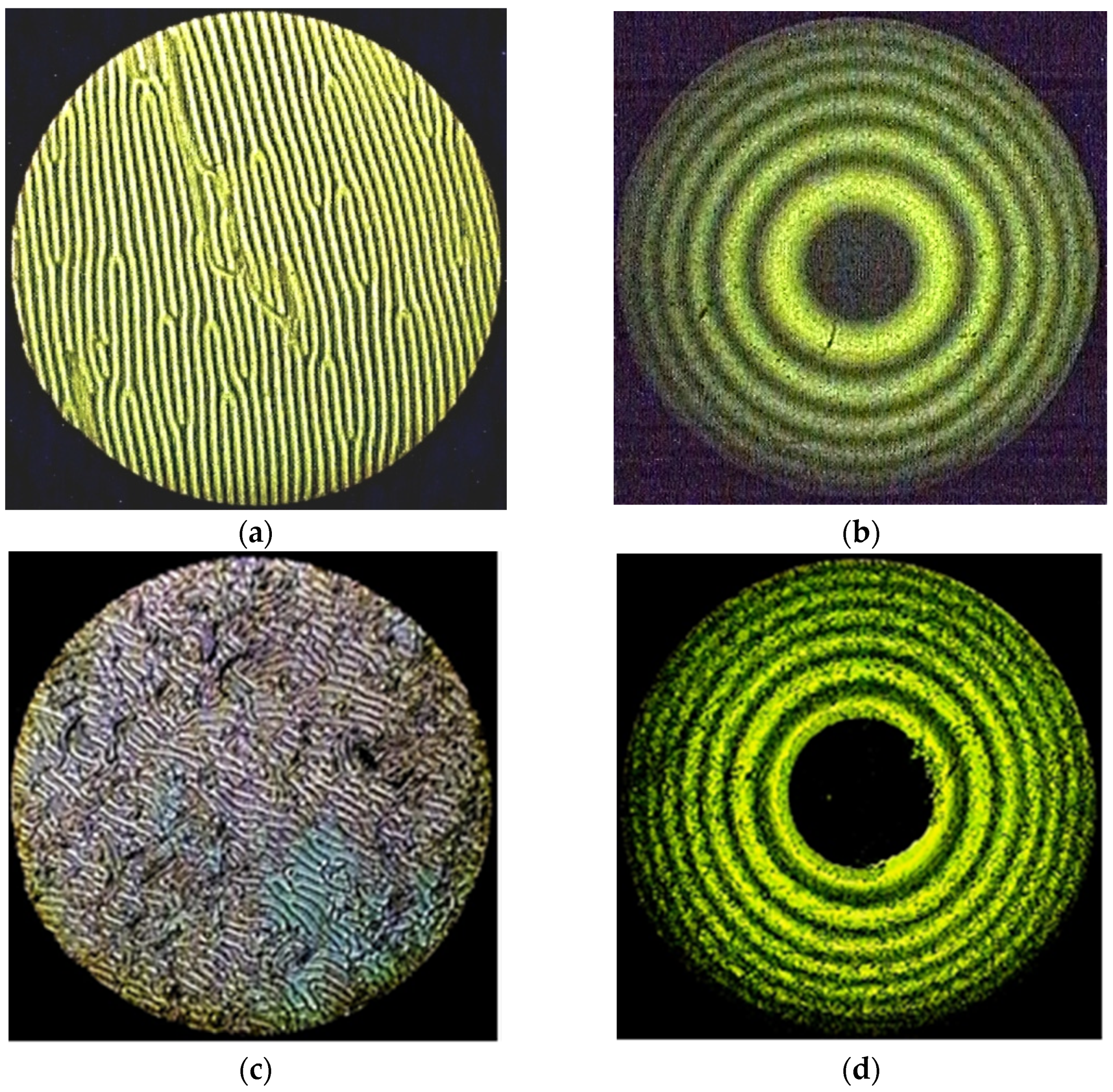

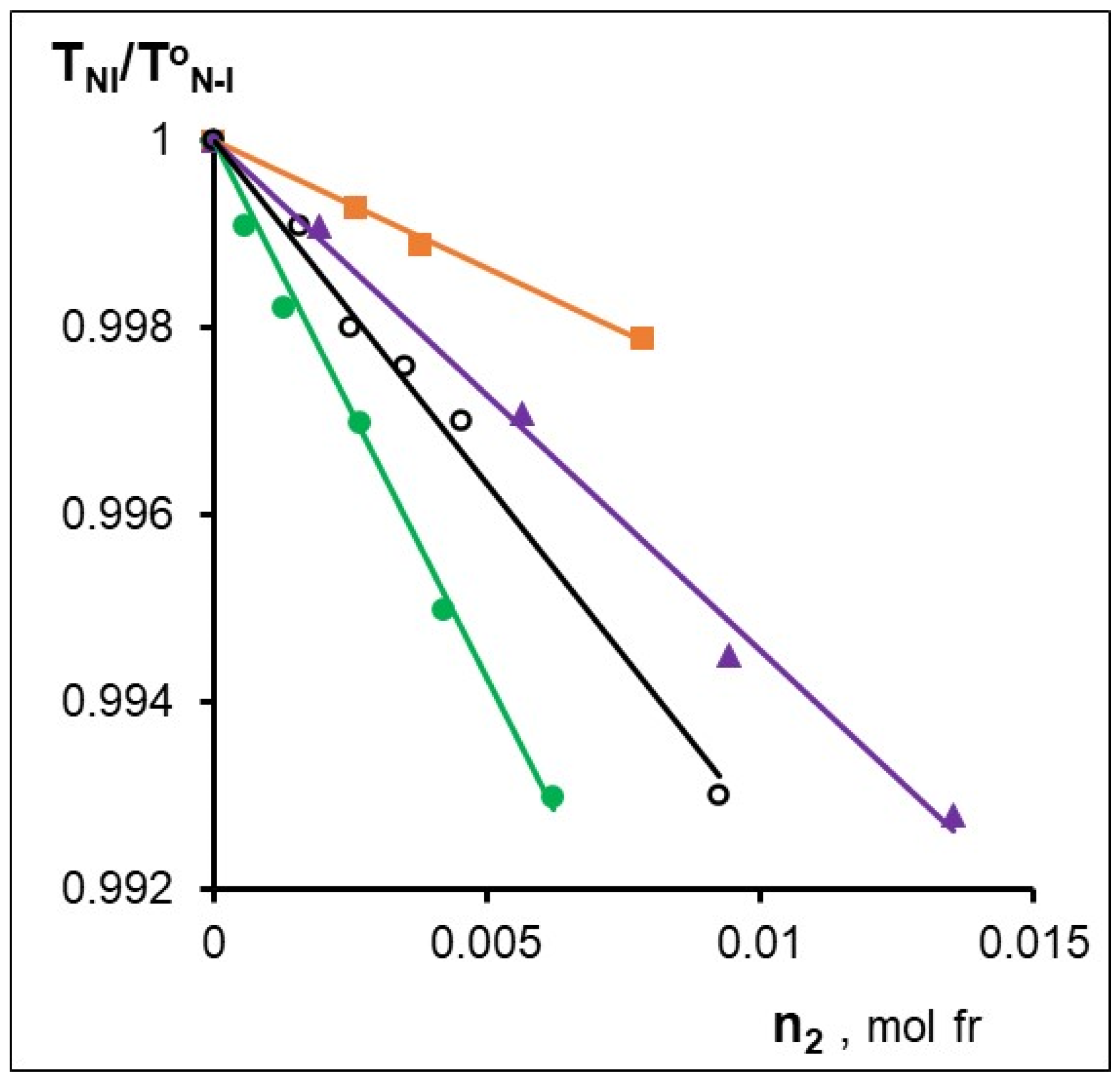
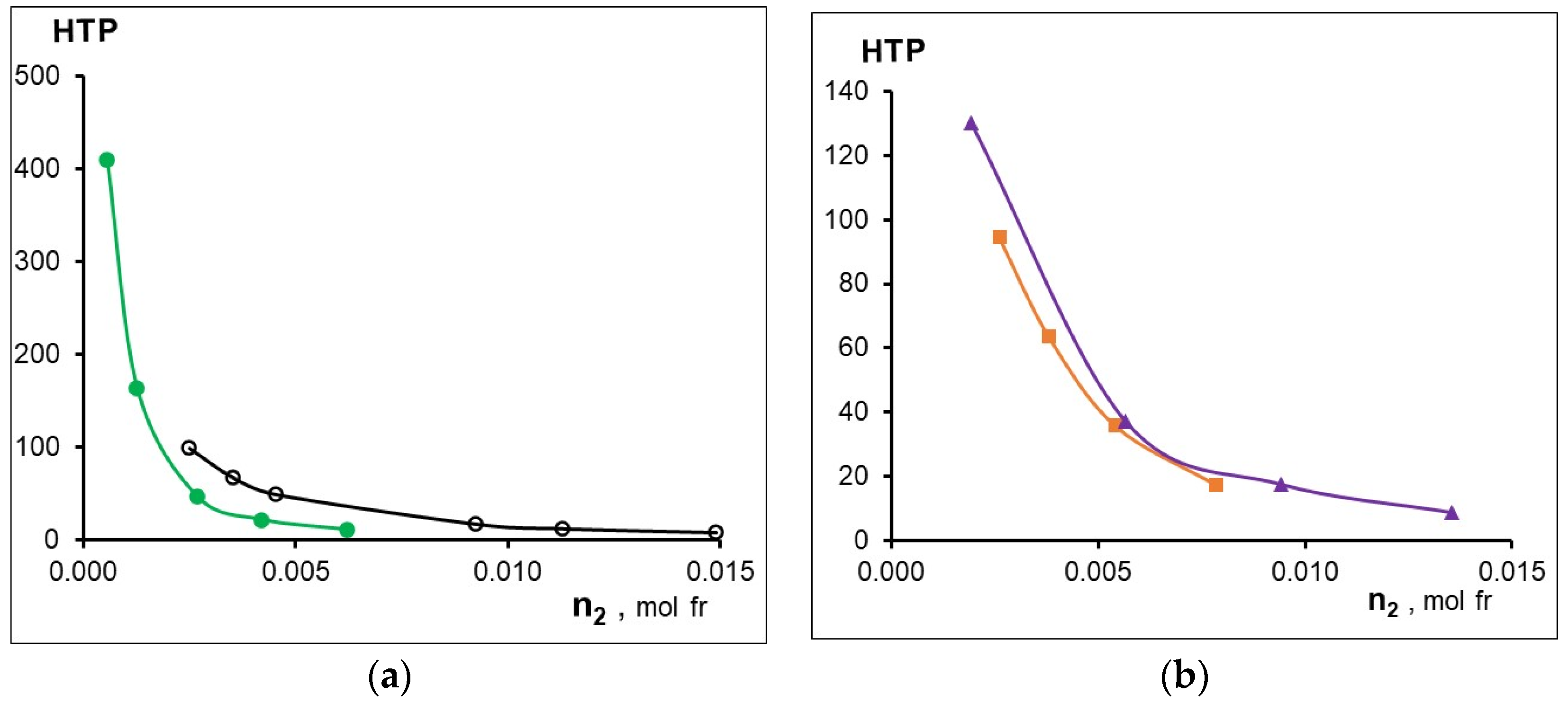
 | ||||
|---|---|---|---|---|
| i | MADMECl | Ni-MADMECl | Zn-MADMECl | Cu-MADMECl |
| 1 | 0.107 | −0.426 | −0.145 | −0.253 |
| 2 | −0.122 | −0.401 | −0.185 | −0.293 |
| 3 | 0.036 | 0.061 | 0.092 | −0.084 |
| 4 | 0.007 | 0.234 | 0.020 | 0.038 |
| 5 | 0.089 | 0.546 | 0.0931 | 0.231 |
| 6 | 0.100 | 0.417 | 0.128 | 0.236 |
| 7 | −0.144 | 0.431 | 0.182 | 0.303 |
| 8 | 0.088 | 0.018 | 0.120 | 0.137 |
| 9 | 0.020 | −0.188 | 0.039 | 0.004 |
| 10 | 0.084 | −0.531 | 0.098 | −0.226 |
| 11 | −0.142 | −0.476 | −0.180 | −0.293 |
| 12 | −0.312 | −0.598 | −0.369 | −0.491 |
| 13 | −0.322 | −0.226 | −0.374 | −0.382 |
| 14 | 0.104 | 0.126 | 0.122 | −0.069 |
| 15 | −0.126 | 0.645 | 0.160 | 0.318 |
| 16 | −0.216 | 0.580 | 0.266 | 0.388 |
| 17 | 0.549 | 0.935 | 0.631 | 0.770 |
| 18 | 0.052 | 0.123 | 0.027 | 0.030 |
| 19 | 0.040 | −0.271 | 0.036 | −0.099 |
| 20 | −0.131 | −0.617 | −0.156 | −0.307 |
| 21 | 0.037 | 0.070 | 0.06 | −0.075 |
| 22 | 0.037 | 0.069 | 0.06 | 0.076 |
| 23 | 0.036 | 0.068 | 0.06 | −0.076 |
| 24 | 0.037 | 0.069 | 0.06 | 0.075 |
| H21 0.027 | (Ni 0.004) | (Zn 0.016) | (Cu 0.01) | |
| H23 0.114 | ||||
| 0.171 | 0.415 | 0.205 | 0.280 | |
| r21–22, Å | r22–23 Å | r23–24 Å | r24–21 Å | r21–23 Å | r22–24 Å | |
|---|---|---|---|---|---|---|
| MADMECl | 3.04 | 2.83 | 3.05 | 2.82 | 4.23 | 4.07 |
| Ni-MADMECl | 2.70 | 2.67 | 2.74 | 2.70 | 3.83 | 3.81 |
| Zn-MADMECl | 2.89 | 2.84 | 2.91 | 2.86 | 4.05 | 4.08 |
| Cu-MADMECl | 2.82 | 2.78 | 2.84 | 2.81 | 3.97 | 3.98 |
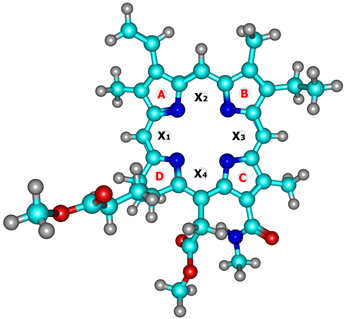 | ||||||||
|---|---|---|---|---|---|---|---|---|
| X1 | X2 | X3 | X4 | A | B | C | D | |
| MADMECl | −12.13 | −10.08 | −10.53 | −11.54 | −0.60 | −2.46 | −3.25 | +5.06 |
| Zn-MADMECl | −14.35 | −12.24 | −11.95 | −14.01 | −6.31 | −8.64 | −8.35 | +4.78 |
| Cu-MADMECl | −15.76 | −13.64 | −13.13 | −15.07 | −5.65 | −8.16 | −8.24 | +4.66 |
| Ni-MADMECl | −16.72 | −14.60 | −13.67 | −15.73 | −4.58 | −6.94 | −7.37 | +4.35 |
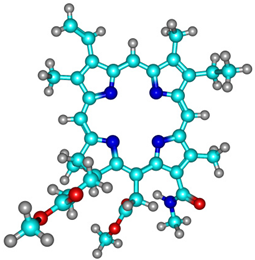 | ||
|---|---|---|
| E (I) au | ΔE = E(I) − E(I) × kcal/mol | |
| 2H | −2083.43 * | |
| Zn | −2083.35 | −3.47 |
| Cu | −2083.34 | 1.62 |
| Ni | −2083.33 | 14.43 |
| λ, nm | Δε, l·mol−1·cm−1 | ε, l·mol−1·cm−1 | g-factor·104 | |
|---|---|---|---|---|
| MADMECl | 400 661 | 18.1 −4.2 | 44697 15621 | 4.05 −2.67 |
| Ni-MADMECl | 417 636 | 91.2 −32.7 | 68981 36574 | 13.22 −8.94 |
| Cu-MADMECl | 408 630 | 55.3 −15.3 | 42931 23172 | 12.87−6.59 |
| Zn-MADMECl | 416 636 | 6.3 −1.2 | 26882 11294 | 2.36 −1.1 |
| Dopant | β, mol.fr.−1 | HTPmax, μM−1 |
|---|---|---|
| MADMECl | −0.73 | 97.9 |
| Zn-MADMECl | −0.54 | 130.4 |
| Cu-MADMECl. | −0.27 | 94.5 |
| Ni-MADMECl | −1.15 | 409.2 |
Disclaimer/Publisher’s Note: The statements, opinions and data contained in all publications are solely those of the individual author(s) and contributor(s) and not of MDPI and/or the editor(s). MDPI and/or the editor(s) disclaim responsibility for any injury to people or property resulting from any ideas, methods, instructions or products referred to in the content. |
© 2023 by the authors. Licensee MDPI, Basel, Switzerland. This article is an open access article distributed under the terms and conditions of the Creative Commons Attribution (CC BY) license (https://creativecommons.org/licenses/by/4.0/).
Share and Cite
Burmistrov, V.; Aleksandriiskii, V.; Novikov, I.; Batrakova, A.; Belykh, D.; Startseva, O.; Koifman, O.I. Acoplanarity, Aromaticity, Chirality, and Helical Twisting Power of Chlorin e6 13(N)-Methylamide-15,17-dimethyl Ester Complexes: Effect of a Metal. Inorganics 2023, 11, 24. https://doi.org/10.3390/inorganics11010024
Burmistrov V, Aleksandriiskii V, Novikov I, Batrakova A, Belykh D, Startseva O, Koifman OI. Acoplanarity, Aromaticity, Chirality, and Helical Twisting Power of Chlorin e6 13(N)-Methylamide-15,17-dimethyl Ester Complexes: Effect of a Metal. Inorganics. 2023; 11(1):24. https://doi.org/10.3390/inorganics11010024
Chicago/Turabian StyleBurmistrov, Vladimir, Viktor Aleksandriiskii, Igor Novikov, Alena Batrakova, Dmitry Belykh, Olga Startseva, and Oskar I. Koifman. 2023. "Acoplanarity, Aromaticity, Chirality, and Helical Twisting Power of Chlorin e6 13(N)-Methylamide-15,17-dimethyl Ester Complexes: Effect of a Metal" Inorganics 11, no. 1: 24. https://doi.org/10.3390/inorganics11010024
APA StyleBurmistrov, V., Aleksandriiskii, V., Novikov, I., Batrakova, A., Belykh, D., Startseva, O., & Koifman, O. I. (2023). Acoplanarity, Aromaticity, Chirality, and Helical Twisting Power of Chlorin e6 13(N)-Methylamide-15,17-dimethyl Ester Complexes: Effect of a Metal. Inorganics, 11(1), 24. https://doi.org/10.3390/inorganics11010024






